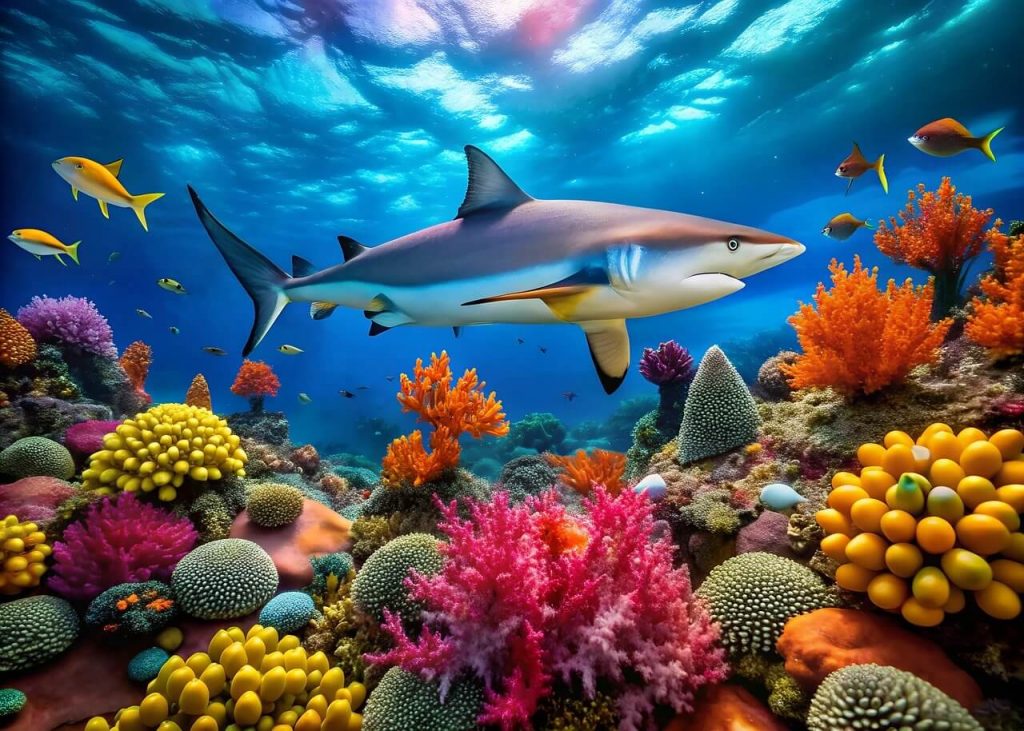Contents
- 1. Whale Shark (Rhincodon typus)
- 2. Basking Shark (Cetorhinus maximus)
- 3. Giant Oceanic Manta Ray (Mobula birostris)
- 4. Megalodon (Carcharocles megalodon)
- 5. Oarfish (Regalecus glesne)
- 6. Beluga Sturgeon (Huso huso)
- 7. Atlantic Bluefin Tuna (Thunnus thynnus)
- 8. Swordfish (Xiphias gladius)
- 9. Tiger Shark (Galeocerdo cuvier)
- 10. Pacific Blue Marlin (Makaira nigricans)
The ocean is a vast and mysterious realm, home to a diversity of life that continues to intrigue scientists, adventurers, and nature lovers alike. Among its most fascinating inhabitants are the giants of the sea: fish that dwarf their smaller counterparts. In this article, we will explore the top ten biggest fish in the world, highlighting their unique characteristics, habitats, and interesting facts.
1. Whale Shark (Rhincodon typus)
Size: Up to 60 feet (18 meters) in length
The whale shark holds the title of the largest fish in the world. These gentle giants can grow up to 60 feet long and weigh as much as 20 tons. Despite their size, whale sharks are filter feeders, consuming plankton, small fish, and crustaceans by swimming with their mouths wide open. Found in warm, tropical oceans worldwide, they are often spotted near the surface and are known to migrate long distances. Unfortunately, they are classified as endangered, primarily due to overfishing and habitat loss.
2. Basking Shark (Cetorhinus maximus)
Size: Up to 40 feet (12 meters) in length
The second largest fish in the world, the basking shark can reach lengths of up to 40 feet. Like the whale shark, basking sharks are filter feeders and primarily consume zooplankton. These sharks can be found in temperate waters all over the globe and are known for their distinctive, large dorsal fin that often breaks the surface while swimming. Basking sharks are also listed as vulnerable due to reduced populations from fishing and boating traffic.
3. Giant Oceanic Manta Ray (Mobula birostris)
Size: Up to 29 feet (8.8 meters) in width
While most people think of fish as having a streamlined, torpedo-like shape, the giant oceanic manta ray defies that norm with its enormous wingspan. Although they are not technically fish (they belong to the family of rays), manta rays are often included in discussions about aquatic giants due to their massive size. With wingspans that can reach up to 29 feet, these graceful creatures inhabit tropical and subtropical waters, often performing acrobatic leaps out of the water. Manta rays are filter feeders and are similarly threatened by fishing and marine pollution.
4. Megalodon (Carcharocles megalodon)
Size: Up to 60 feet (18 meters) in length (extinct)
The megalodon, one of the largest and most powerful predators to ever roam the oceans, lived around 23 million years ago and is thought to have reached lengths similar to those of the whale shark. Although it has been extinct for millions of years, the megalodon still captures the imagination of many as a symbol of prehistoric oceanic ferocity. Researchers believe this massive shark fed on whales and other large marine animals, utilizing its immense size and powerful jaws to catch prey.
5. Oarfish (Regalecus glesne)
Size: Up to 36 feet (11 meters) in length
The oarfish is known as the “king of herrings” and is the longest bony fish in the world, measuring up to 36 feet in length. With its serpentine body and dorsal fin that runs along the length of its body, the oarfish has a unique appearance that resembles a mythical sea creature. Often dwelling in deep ocean waters, oarfish are rarely seen by humans. They are believed to inhabit depths up to 3,000 feet and have been seen near the surface, particularly when ill or dying.
6. Beluga Sturgeon (Huso huso)
Size: Up to 23 feet (7 meters) in length
Beluga sturgeons are not only notable for their size but also for their incredible longevity, living for over 100 years. These ancient fish can reach lengths of over 23 feet and weigh more than 2,000 pounds. They primarily inhabit the Caspian and Black Sea basins and are best known for their roe, which is used to make caviar. Unfortunately, they face severe threats from overfishing and habitat degradation, leading to a significant decline in their population and their current status as critically endangered.
7. Atlantic Bluefin Tuna (Thunnus thynnus)
Size: Up to 16 feet (5 meters) in length
The Atlantic bluefin tuna is renowned not only for its size but also for its speed and strength. Capable of reaching lengths of up to 16 feet and weighing upwards of 1,500 pounds, these fish are highly sought after in the fishing industry, especially for sushi markets. Found in the North Atlantic Ocean, bluefin tuna are migratory fish that can travel vast distances. Their populations have drastically declined due to overfishing, leading to international conservation efforts to protect these magnificent creatures.
8. Swordfish (Xiphias gladius)
Size: Up to 16 feet (4.8 meters) in length
The swordfish is another apex predator that can grow up to 16 feet long. Recognized for its distinctive elongated bill, the swordfish is a powerful swimmer known for its speed and strength. Found in both temperate and tropical oceans, swordfish are capable of diving to depths of over 1,500 feet to pursue prey. While they are popular in commercial and sport fishing, the swordfish populations are under pressure due to overfishing and habitat loss.
9. Tiger Shark (Galeocerdo cuvier)
Size: Up to 16 feet (4.8 meters) in length
The tiger shark is a formidable predator, recognized for its striking stripes and voracious appetite. Growing up to 16 feet long, these sharks exhibit a wide range of dietary preferences, consuming a diverse array of prey, including fish, seals, birds, and even non-food items like trash. Tiger sharks inhabit tropical and subtropical waters around the world and are known for their adaptability but also face threats from commercial fishing activities, leading to a decrease in their populations.
10. Pacific Blue Marlin (Makaira nigricans)
Size: Up to 14 feet (4.3 meters) in length
The Pacific blue marlin is one of the largest game fish and can grow to impressive lengths of up to 14 feet. With its elongated body and iconic spear-like bill, the blue marlin is renowned for its strength and agility. Found in the warm waters of the Pacific and Indian Oceans, blue marlins require deep ocean environments with abundant prey such as smaller fish and squid. As a result of their popularity in sport fishing, they face pressures from overfishing, and conservation efforts are underway to protect this majestic species.
The world’s largest fish are not only awe-inspiring because of their size but also significant players in the marine ecosystem. From the gentle giants like the whale shark and basking shark to ferocious predators like the tiger shark and blue marlin, these fish face numerous threats from human activities such as overfishing, habitat destruction, and climate change. Conserving their populations is crucial for maintaining the biodiversity and health of our oceans. By learning more about these remarkable creatures, we can better appreciate their place in the natural world and work towards protecting them for future generations.




